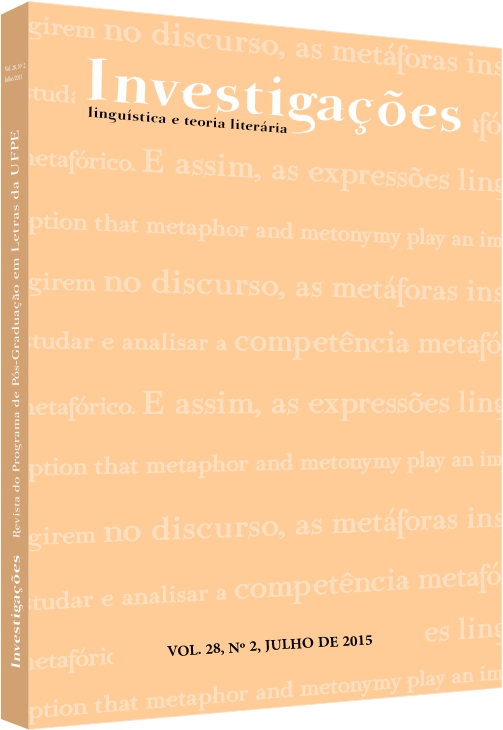A polissemia do cabra à luz da teoria da metáfora conceptual
Resumo
Resumo: Segundo a visão da mente corpórea em Lakoff e Johnson (1980) e em Lakoff (1987), mapeamentos metonímicos e metafóricos motivariam conceitos mais abstratos estruturados por palavras polissêmicas a exemplo da expressão convencional cabra usada por membros da comunidade nordestina brasileira, que, além de se referir ao dito animal, refere-se a homem em geral ou a certos tipos de homens. Esse trabalho visa discutir a polissemia da expressão cabra à luz da Teoria da Metáfora Conceptual a partir de dados obtidos entre os anos de 2010 e 2013 com pesquisa realizada por ocasião de tese de doutorado.
Referências
CASCUDO, Luís Câmara - Coisas que o povo diz – 2ª edição. São Paulo: Globo Editora, 2009. (1ª. edição, 1968) Bloch.
CAVALCANTI, Fernanda C. A análise da expressão convencional cabra sob a perspectiva da teoria dos modelos cognitivos idealizados. 2014. 246p. Tese. (Doutorado em Linguística). Programa de Pós-Graduação em Linguística, Universidade Federal do Ceará, Fortaleza, 2014.
FELTES, Heloísa Pedroso de Moraes. Semântica cognitiva: ilhas, pontes e teias. Porto Alegre: Edipurcs, 2007.
FERREIRA, Aurélio Buarque de Holanda. Dicionário Aurélio da Língua Portuguesa. 5 ed. Editora Positivo, 2004.
FREYRE, Gilberto. Nordeste - 7ª edição. São Paulo: Global Editora, 2004. (1ª edição: 1937.
GEERAERTS, Dirk. A prática definitória dos dicionários e a concepção semântico-cognitiva de polissemia. In: SIQUEIRA, Maity (Org.). Cadernos de Tradução. Porto Alegre. n 25. p.55-76, jul-dez. 2009.
GIBBS, Raymond. The poetics of mind: Figurative thought, language, and understanding. New York: Cambrigde University Press, 1994.
GRADY, Joseph. Foundations of meaning: primary metaphors and primary scenes. 1997. PhD Dissertation. Graduate Division, University of California, Berkeley, 1997.
KÖVECSES, Zoltán. Metaphor in culture: universality and variation. Nova York: Cambridge University Press, 2005.
______. Metaphor: a practical introduction. Nova York: Oxford University Press, 2010. 2a edição.
LAKOFF, George. JOHNSON, Mark. Metáforas da Vida cotidiana. São Paulo/Campinas:Educ/Mercado de Letras, 1980.
LAKOFF, George. Women, fire and dangerous things: what categories reveal about the human mind. Chicago: University of Chicago Press, 1987.
______, George. The contemporary theory of metaphor. (in) Metaphor and Thought. (Org.). Ortony, Andrew. Nova York: Cambridge University Press, p.1-47, 1993.
MACEDO, Ana Cristina Pelosi de. - Categorização semântica: uma retrospectiva de teorias e pesquisa. (in) Revista do Gelne, Vol. 4, n. 1/2, 2002.
______, Ana Cristina Pelosi de. Cognição e linguística. In: MACEDO, Ana Cristina. Pelosi de; FELTES, Heloísa Pedroso de Moraes; FARIAS, Emília Maria Peixoto (Org.). Cognição e linguística: explorando territórios, mapeamentos e percursos. Caxias do Sul: Educs; Porto Alegre: Edipucrs, 2008. p. 9-37.
RAKOVA, Markova. The extent of the literal. Nova York: Palgrave, 2003.
ROSCH Eleanor ET AL. Basic Objects in Natural Categories. Cognitive Psychology. Vol.8, 1976. p. 382-439.
SILVA, Augusto Soares da. O mundo dos sentidos em português – polissemia, semântica e cognição. Coimbra: Almedina, 2006.
WELKER, Herbert Andreas. Dicionários: uma pequena introdução à lexicografia. Brasília: Thesaurus, 2004.
Downloads
Publicado
Como Citar
Edição
Seção
Licença
Copyright (c) 2015 Fernanda Carneiro Cavalcanti

Este trabalho está licenciado sob uma licença Creative Commons Attribution 4.0 International License.
Autores que publicam na Revista Investigações concordam com os seguintes termos:
Autores mantêm os direitos autorais e concedem à revista o direito de primeira publicação, com o trabalho simultaneamente licenciado sob a licença Creative Commons Atribuição 4.0 Internacional (CC BY 4.0) que permite o compartilhamento do trabalho com reconhecimento da autoria e publicação inicial nesta revista.
Autores têm autorização para assumir contratos adicionais separadamente, para distribuição não-exclusiva da versão do trabalho publicada nesta revista (exemplo: depositar em repositório institucional ou publicar como capítulo de livro), com reconhecimento de autoria e publicação inicial nesta revista.
Qualquer usuário tem direito de:
Compartilhar — copiar e redistribuir o material em qualquer suporte ou formato para qualquer fim, mesmo que comercial.
Adaptar — remixar, transformar e criar a partir do material para qualquer fim, mesmo que comercial.
O licenciante não pode revogar estes direitos desde que você respeite os termos da licença.
De acordo com os termos seguintes:
Atribuição — Você deve dar o crédito apropriado, prover um link para a licença e indicar se mudanças foram feitas. Você deve fazê-lo em qualquer circunstância razoável, mas de nenhuma maneira que sugira que o licenciante apoia você ou o seu uso.
Sem restrições adicionais — Você não pode aplicar termos jurídicos ou medidas de caráter tecnológico que restrinjam legalmente outros de fazerem algo que a licença permita.

